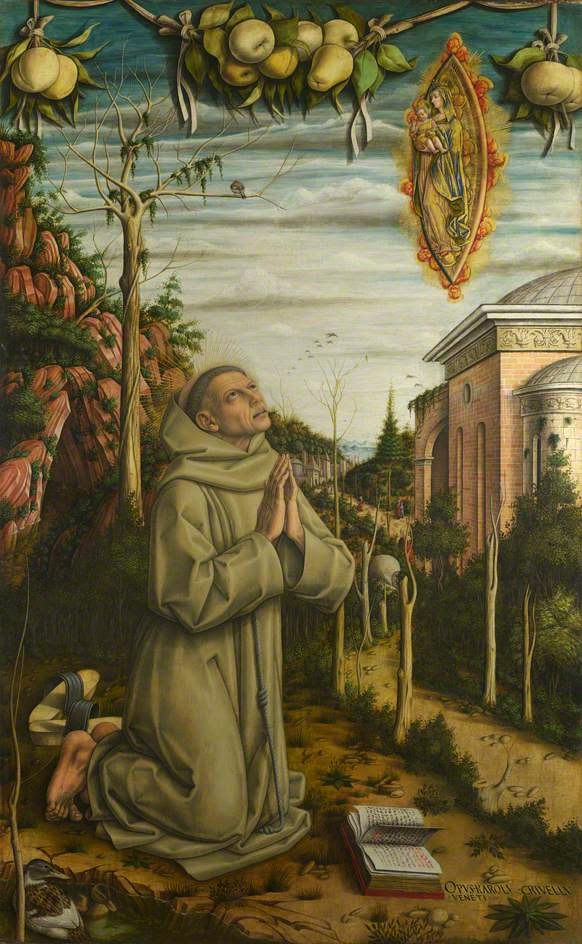My brief and very oversimplified history of art movements through the eye of the humble apple
Ancient
My earliest example is this silver coin dated to 560-546 BC from the British Museum it could be a pomegranate but I see an apple. Many pre-Roman coins did not have the rulers faces on them that we have become so accustomed to seeing. Often instead they had simplified images of animals or objects and in this case fruit.
Greek
This frieze from a Greek vase shows the Hesperides or nymphs who were the daughters of Atlas. Alongside the Ladon the 100 headed dragon, shown here as really more of a snake, they are guarding the golden apples belonging to Zeus.
Roman
Fresco found at Pompeii from the second style from the 1st century BC preserved by the eruption of Vesuvius we can see that people have always been fascinated by still life.
Romanesque
The temptation of Eve by the sculptor Gislebertus c.1130 Musee Rolin.
Medieval
A page from an illustrated manuscript c.1445 showing God pointing out the apple to Adam and Eve from the New York Public Library
Italian Renaissance
Carlo Crivelli The Vision of the Blessed Gabriele from the National Gallery. Carlo Crivelli often included apples and pears in his depictions of the Madonna and Child. Here we see Gabriele the superior of a Franciscan convent having a vision of the Virgin Mary and baby Jesus in a Mandorla (Almond shaped apparition) on the top right. The Mandorla is surrounded by large green apples.
Northern Renaissance
Lucas Cranach's Mother and child are seated under an apple tree abundant with ripe fruit.
Baroque
Caravaggio's c.1599 fruit basket with its careful details starts to take us into the flamboyant lush and luxurious Baroque and Rococo styles. Caravaggio's fruit is far from perfect and idealised like the previous two images. He has painted every bruise every rotten worm hole. This image is also notable as it is considered by many to be the first example of a still life of a basket of fruit, which became such a staple part of the still life genre.
Neoclassical
I wouldn't have thought you get get a neoclassical apple but I was wrong. Here in John Vanderlyn's 1854-1858 painting from the Albany Institute of history and art the carefully rendered apples are set in a mock classical setting on an ornate marble tabletop.
Pre-Raphaelite/Romanticism
Rossetti's Venus Verticordia 1863-68 who sits shrouded in roses and a luminous halo holds a golden apple on which is perched a bright yellow butterfly.
Realism
Courbet
Courbet's apple is hidden in the background. He has taken particular care to paint the fruit's irregularities. Gone are the perfect spheres and consistent colours of Cranach's uniform apples.
Impressionism
Renoir
Here we can see all the colors that Renoir injects into the white cloth the apples sit on. The apples themselves are painted with the artists strong brush strokes and particular care has been taken to convey the bright specks of light reflecting on the apples shiny surfaces.
Post-Impressionism
Cezanne painted hundreds of apples during his lifetime. He really explored the apple as a form seeking to understand its shape from every angle and how to convey that in paint. He changed the way that artists looked at objects.
Abstraction - Well the move towards it
In this painting by the abstract artist Ben Nicholson we can see how he has broken down the apple to its fundamental geometrical elements in this move towards abstraction.
Surrealism
In one of Magritte's most famous paintings the Son of Man an exaggeratedly perfect green apple hangs suspended in space in front of a gentleman's face. The smartly dressed gentleman is Magritte himself.
Pop Art
One of Warhol's series of colourful screenprints of the Macintosh logo. Warhol once met a young Steve Jobs at a party for the 9 year old Sean Lennon. Job's had given Sean an early Macintosh computer and was teaching everyone to use paint including Warhol himself.
Contemporary
Anne Rook uses the stickers from familiar brands of apples and sticks them to the apple itself in the Book of Golden Delicious 4021 4020. She is commenting on consumer culture, mass production and globalisation of food production.

















No comments:
Post a Comment